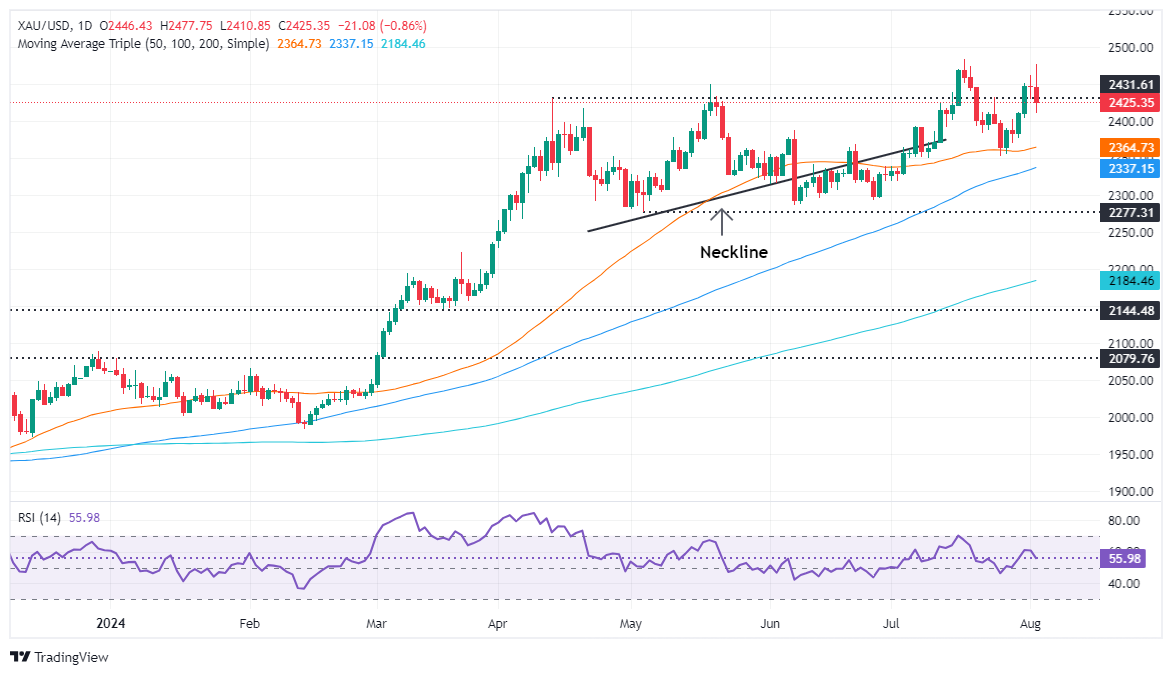- Analiza
- Novosti i instrumenti
- Vesti sa tržišta
- Gold price tumbles after hitting two-week high amid Fed rate cut speculation
Gold price tumbles after hitting two-week high amid Fed rate cut speculation
- Gold price drops to $2,420 after peaking at $2,477, down nearly 0.80%.
- US Nonfarm Payrolls for July miss expectations, unemployment rate rises to 4.3%.
- Treasury yields and USD plunge, prompting banks to anticipate faster Fed rate cuts.
Gold price reversed its course and tumbled almost 1% after hitting a two-week high of $2477 following weaker-than-expected data from the United States (US). This weighed on the Greenback and sent US Treasury yields plummeting as investors expected the Federal Reserve could cut rates faster than they thought. The XAU/USD trades at $2,420 at the time of writing
XAU/USD whipsaws as disappointing US economic indicators weigh on the Greenback and Treasury yields
Friday’s US Nonfarm Payrolls figures disappointed investors, which were still digesting a dismal ISM Manufacturing PMI report that spurred concerns about the health of the US economy.
The US Department of Labor revealed that 114K people were added to the workforce in July, missing estimates of 175K, and the previous figures were downward revised from 206K to 179K. Further data showed the Unemployment Rate ticked up from 4.1% to 4.3% and Average Hourly Earnings dipped a tenth from 0.3% to 0.2%.
Bullion rallied sharply, capitalizing on the fall of the US 10-year Treasury bond yield, which tanked over 15 basis points to 3.815%. The Greenback was also hurt, collapsing more than 1.13% according to the US Dollar Index (DXY), which is at 103.16.
After the data, most banks began to price in more aggressive monetary policy easing by the Fed. Bank of America expects the first cut in September instead of December, while Citi and JP Morgan expect the Fed to lower rates by 50 bps in September and November.
XAU/USD Price Analysis: Technical outlook
Gold price has retreated toward the July 31 lows of $2,404-$2,410, which could be attributed to profit-taking ahead of the weekend, as US yields and the Greenback remain at weekly lows. From a technical standpoint, XAU/USD is set to remain bullish and if buyers achieve a daily close above $2,450, this could exacerbate a challenge towards the all-time high, ahead of the $2,500 mark. On further weakness, prices could fall below $2,400, which could pave the way for a pullback to the 50-day moving average (DMA) at $2,364, before testing the 100-DMA at $2,337.
Gold FAQs
Gold has played a key role in human’s history as it has been widely used as a store of value and medium of exchange. Currently, apart from its shine and usage for jewelry, the precious metal is widely seen as a safe-haven asset, meaning that it is considered a good investment during turbulent times. Gold is also widely seen as a hedge against inflation and against depreciating currencies as it doesn’t rely on any specific issuer or government.
Central banks are the biggest Gold holders. In their aim to support their currencies in turbulent times, central banks tend to diversify their reserves and buy Gold to improve the perceived strength of the economy and the currency. High Gold reserves can be a source of trust for a country’s solvency. Central banks added 1,136 tonnes of Gold worth around $70 billion to their reserves in 2022, according to data from the World Gold Council. This is the highest yearly purchase since records began. Central banks from emerging economies such as China, India and Turkey are quickly increasing their Gold reserves.
Gold has an inverse correlation with the US Dollar and US Treasuries, which are both major reserve and safe-haven assets. When the Dollar depreciates, Gold tends to rise, enabling investors and central banks to diversify their assets in turbulent times. Gold is also inversely correlated with risk assets. A rally in the stock market tends to weaken Gold price, while sell-offs in riskier markets tend to favor the precious metal.
The price can move due to a wide range of factors. Geopolitical instability or fears of a deep recession can quickly make Gold price escalate due to its safe-haven status. As a yield-less asset, Gold tends to rise with lower interest rates, while higher cost of money usually weighs down on the yellow metal. Still, most moves depend on how the US Dollar (USD) behaves as the asset is priced in dollars (XAU/USD). A strong Dollar tends to keep the price of Gold controlled, whereas a weaker Dollar is likely to push Gold prices up.
© 2000-2025. Sva prava zaštićena.
Sajt je vlasništvo kompanije Teletrade D.J. LLC 2351 LLC 2022 (Euro House, Richmond Hill Road, Kingstown, VC0100, St. Vincent and the Grenadines).
Svi podaci koji se nalaze na sajtu ne predstavljaju osnovu za donošenje investicionih odluka, već su informativnog karaktera.
The company does not serve or provide services to customers who are residents of the US, Canada, Iran, The Democratic People's Republic of Korea, Yemen and FATF blacklisted countries.
Izvršenje trgovinskih operacija sa finansijskim instrumentima upotrebom marginalne trgovine pruža velike mogućnosti i omogućava investitorima ostvarivanje visokih prihoda. Međutim, takav vid trgovine povezan je sa potencijalno visokim nivoom rizika od gubitka sredstava. Проведение торговых операций на финанcовых рынках c маржинальными финанcовыми инcтрументами открывает широкие возможноcти, и позволяет инвеcторам, готовым пойти на риcк, получать выcокую прибыль, но при этом неcет в cебе потенциально выcокий уровень риcка получения убытков. Iz tog razloga je pre započinjanja trgovine potrebno odlučiti o izboru odgovarajuće investicione strategije, uzimajući u obzir raspoložive resurse.
Upotreba informacija: U slučaju potpunog ili delimičnog preuzimanja i daljeg korišćenja materijala koji se nalazi na sajtu, potrebno je navesti link odgovarajuće stranice na sajtu kompanije TeleTrade-a kao izvora informacija. Upotreba materijala na internetu mora biti praćena hiper linkom do web stranice teletrade.org. Automatski uvoz materijala i informacija sa stranice je zabranjen.
Ako imate bilo kakvih pitanja, obratite nam se pr@teletrade.global.
















